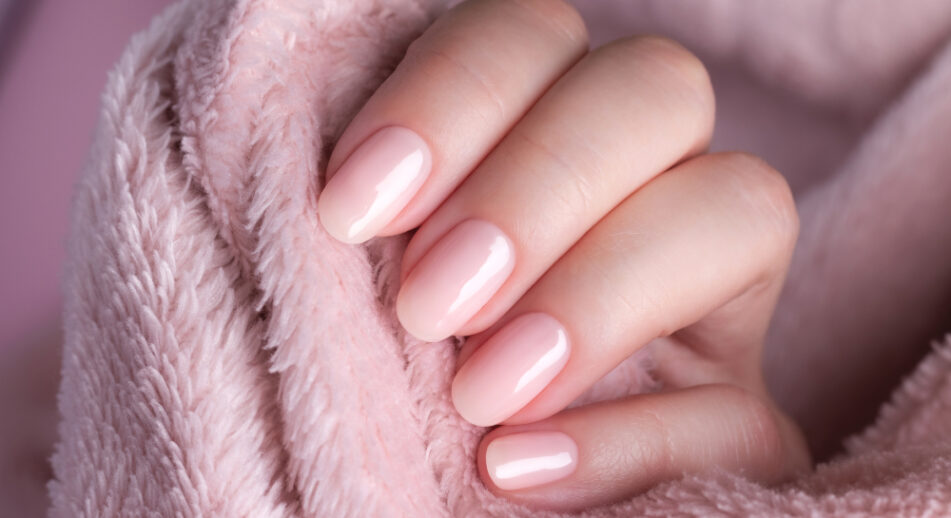Gel vs Acrylic Nails: What's the Difference and What Is Better?

Getting your nails done can feel like a vocabulary lesson – acrylic, hard gel, dip powder, etc. What’s really the difference between these different manicure techniques?
In this piece, we’ll clear up the differences between two manicures that often get confused – gel and acrylic nails. Even though the finished product is nearly chemically identical, there are major differences in process, durability, and maintenance.
At the end of the day, is gel or acrylic better for you? Read on to find out!

What Are Acrylic Nails?
In order to discuss gel vs acrylic nails, we first need to understand what they are made of.
A monomer is any substance with larger-than-normal molecules (macromolecules) that can link together to form a polymer. When a monomer comes into contact with an oxidizing agent (like the peroxide in acrylic dip powder), it begins to polymerize.
Polymers tend to be strong, solid substances that can withstand a lot of abuse. Every plastic you use on a day-to-day basis is a polymer.
Acrylic nails are made by combining a liquid monomer with a powdered polymer that contains an activating substance. Mixing the two together creates a bead of poly(methyl methacrylate), also known as PMMA, acrylic glass, or just acrylic. Once the bead is formed on the nail, it can be spread and shaped to form a sculpted nail tip.
A Tiny Bit of History
The history of acrylic nails began in the most unlikely of places: the dentist’s office.
By the 1950s, PMMA was used in dentist’s offices for prosthetics and false teeth. In 1954, a dentist named Frederick Slack cut off a big chunk of his thumbnail. After some experimentation, he used a monomer and a polymer to create a false thumbnail out of PMMA.
Slack’s brother Tom, also a dentist, was fascinated by the creation. Together, the Slack brothers ditched the dentistry business and founded an artificial nail company.
Application
When you’re getting acrylic nails, the nail tech starts by prepping your nails with a dehydrating primer. Water can inhibit the acrylic mixture from sticking to the nail, so it’s important to make sure things are as dry as possible.
Then, the tech will dip a brush in liquid monomer and then in acrylic polymer powder. A bead of acrylic will form on the brush, and the tech will transfer it to your nail.
Next, the tech will shape the acrylic depending on the style you’ve chosen. They can cover the whole nail with acrylic or just focus on building the tip.
Acrylic sets pretty quickly, especially in warm rooms. It shouldn’t take much longer than 10 minutes for your nails to dry completely.
A set of acrylic nails can last six to eight weeks, though you may need to get your nails filled after three to four. A nail fill involves getting extra acrylic applied to the base of your nails where it’s grown out.
Removal
Acrylics may be relatively fast going on, but they do take some time to come off. It’s best to get acrylic removal at a salon – a nail technician can help you avoid cracking or tearing your natural nails.
Typically, a technician will use cotton balls soaked in acetone on your nails. The cotton balls are usually held in place with pieces of aluminum foil. This process takes about 15 minutes.
After that, a technician will file and buff the remaining acrylic off.

What Are Gel Nails?
Gel products are used in several different ways, so they can be a bit confusing. Essentially, the gel is a mixture of monomers and polymers in a semi-liquid solution, like a premixed acrylic.
Because this solution doesn’t have an oxidizing agent, it can stay liquid almost indefinitely. That makes gel nails much easier to work with. Using focused UV light from a lamp cures the polish extremely quickly.
What’s the difference between gel polish and builder gel?
While they’re the same unreacted mixture of polymers and monomers, they’re designed for different purposes. Gel nail polish isn’t as thick and just needs to carry colour well.
Unlike gel nail polish, gel builder is designed to strengthen natural nails. It contains chemicals that make the liquid more viscous and the finished gel stronger. Hard gel is designed to strengthen nails as well as add length, and it sets a bit thicker still.
History
Nail artists loved working with acrylics but were on the lookout for a product that was easier to use, less brittle, and more natural-looking.
The first gel polishes came on the market in the early 1980s, but they were hardly a success. There was limited education available for nail techs working with the new substance, and this led to some pretty bad manicures. Plus, the early UV lights were frequently not calibrated correctly, leading to clients experiencing discomfort while curing their nails.
By the end of the 1990s, gel nails were back on the scene, new and better than ever. With proper knowledge and equipment, a gel manicure soon became a great alternative to acrylic nails. And in the past 20 years, they’ve only gotten better.
Application
Gel polish application is much easier than acrylics. The technician will simply paint your nails, drying them under a UV light after each coat. The time spent under the UV light varies depending on the polish and the bulb intensity, but it’s typically 90 seconds or less.
The focused and directed UV rays from a gel lamp can be damaging to your skin, even if your hands are only under them for a short length of time. You can apply sunscreen to your hands before your appointment or wear fingerless gloves to mitigate some of the risk.
Gel builders and hard gel nails follow the same process. They are applied a little differently, though, since the goal of these gels is to strengthen the natural nail. You may need several coats to get the desired effect.
Gel polish should only be worn for about two weeks, while gel builder or hard gel nails will last you four weeks.
Removal
Removal of gel nails is pretty much the same as for acrylics. Gel nails are less likely to cause damage to your natural nails on removal, but it’s still best to have them removed at the salon.
After keeping your nails in contact with acetone for 10-15 minutes, a nail technician should be able to gently buff and remove the polish or builder gel.

Gel vs Acrylic Nails
Though these two compounds are chemically similar, the processes are different, and the effects on your nails are different. Both have their pros and cons.
Safety
Acrylic manicures are safe to get from reputable salons. MMA, a dangerous chemical used as a monomer, has been banned in Canada for 20 years. However, it’s still sometimes sold on sketchy online websites and used in unlicensed salons.
The monomer currently used for acrylic nails, EMA, is much safer, though it’s still very smelly and can cause an allergic reaction in some people. It’s also highly flammable.
Gel nail application contains fewer smelly and flammable chemicals. And while there is a tiny risk of allergic reaction from a gel, it’s less risky than EMA.
Whether you get a gel or an acrylic manicure, it’s safest to get one from a licensed technician working at a reputable salon. And if you have skin irritation or a rash after getting a manicure, you should talk to your doctor.
Application
An acrylic nail appointment can be as short as 45 minutes or as long as three hours, depending on what you need done. Gel polish appointments can be as short as 55 minutes, while gel builder/hard gel appointments can take 3 hours or more.
The amount of time you spend at the salon is more about the look you want and the skill level of the technician than whether you get gel or acrylic.
Look
Acrylic nails dry thicker than gels and tend to look more artificial. If you’re going for a truly radical manicure, that may be just what you’re looking for!
Gels, on the other hand, tend to look more natural. Others will probably assume you’re just wearing regular nail polish. Hard gel is closer in appearance to acrylic than builder gel, but they both don’t look like artificial nails.
Durability
When cared for correctly, acrylics can last about six to eight weeks. A hard gel manicure only lasts half that at four weeks.
However, an acrylic manicure needs a fill at about four weeks. No matter which way you go, you should plan on being in the salon at least once a month.
Maintenance
Acrylic nails are extremely tough, but they can also be quite brittle. They’re not a good choice if you lift heavy objects or play contact sports. You should always wear rubber gloves while doing household chores like washing the dishes or scrubbing the floor.
Gel nails aren’t as thick as acrylics, but they’re more flexible. You should still wear gloves while doing chores, but they’re less likely to get damaged or chipped from normal wear and tear.
Removal
The process for removing acrylic nails and gel nails is similar: extended contact with acetone followed by buffing the nails out. However, gel nails require far less buffing during removal than acrylic nails. That makes removing gels a much less damaging process.
Builder gel can also help nails grow stronger. Even after you remove the gel, your nails will be stronger than they were before.
In order to minimize damage to the natural nail, you should always go to a salon to remove a gel or acrylic manicure.
Cost
Gel and acrylic manicures cost roughly the same. The cost is more about the particular salon and the kind of manicure you want (nail art, chrome powder, etc.)
Beware of any salon offering a price that’s too good to be true. They could be using untrained technicians or counterfeit products.

Acrylic and Gel Nails - What’s Best for You?
Gel
If you lead an active lifestyle and want natural-looking nails, a gel manicure is perfect for you. You can have a stylish manicure that lasts for weeks and isn’t too fussy.
Gel manicures are also great for those who are worried about chemical sensitivities.
Acrylic
Acrylic nails are for those who are willing to risk a little damage and suffer a little inconvenience for truly extraordinary nails. If you’re looking for a more understated style that wears well, acrylics might not be the right choice.
High-Quality Gel Nails in Burlington, ON
At Private Nail Studio, we believe in beautiful nail artistry that enhances your natural nails. Our builder gel and hard gel techniques avoid over-filing and skip artificial nail tips altogether. No harsh acrylics here!
Our relaxing spa atmosphere is the perfect place to get a gorgeous manicure. Book an appointment at our Burlington nail salon today!
